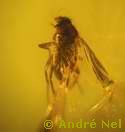Tuesday, August 29, 2006
Amber find shows Amazon as biodiversity hotspot
In northern Peru, 15 to 12 million years ago, insects, mites and other arthropods became trapped in resin on tree trunks and branches. They were discovered, fossilized in amber, by an international team of paleontologists and geologists(1). This discovery is the first of its kind in western Amazonia, and it has enabled the researchers to show that high terrestrial biodiversity existed early on in the region, in a forest environment with a hot, humid climate. These findings have been published on line on the web site of the Proceedings of the National Academy of Sciences [1].
The amber, which is fossilized resin, comes from a single stratigraphic level dating from the middle Miocene (15 to 12 million years ago). It was discovered by the researchers on the banks of the Amazon during a field trip in the Iquitos area in 2004. The team, coordinated by Pierre-Olivier Antoine, from the Laboratory for Transfer Mechanisms in Geology (Laboratoire des mécanismes de transfert en géologie, CNRS/Université Toulouse 3/IRD), has for several years been exploring the sedimentary formations in this region, which is located at the foot of the Andes on the border of Brazil, Ecuador and Colombia. Their goal is to find out how the fauna and flora, environments and geography of western Amazonia have evolved over the past twenty million years under the influence of the uplift of the Andes. This is one of the goals of the Past Environments and Climates program (Environnements et climats du passé, ECLIPSE), a multidisciplinary program run by INSU-CNRS.
Today, Amazonia is the area with the greatest terrestrial biodiversity in the world, but very little is known about the past of this remote and little-explored region, which was totally cut off from the rest of the world 12 to 15 million years ago (the Panama isthmian strait closed up only 3.5 million years ago). The insect and arachnid fossils found by the team are the first terrestrial arthropods ever discovered in this part of the world. Amber from Amazonia contains unusually high amounts of animals and plants. At least 13 species of insect and 3 species of mite have already been identified by André Nel, a paleoentomologist from the National Museum of Natural History (Muséum National d'Histoire Naturelle, MNHN) in Paris. For instance, the fossilized resin trapped several flies and mosquitoes, parasitic wasps, a beetle related to the ladybirds, a caddis fly (well-known to anglers), and so on. There is even a mite caught up in a spider's web.
A huge quantity of microfossils were trapped by the resin, including a wide range of bacteria, cyanobacteria, fungal spores, algae, and even a lichen and a pollen grain. The cell content of certain microfossils has been preserved, which means that it may be possible to access their DNA and attempt to reconstruct their phylogeny (i.e. their family tree). Thanks to this discovery, the researchers now know that 12 to 15 million years ago the region was a delta opening out into an inland sea surrounded by dense forest, with a climate that was already hot and very humid, and where it probably wouldn't have been much fun to live!
Source: The Centre National de la Recherche Scientifique (National Center for Scientific Research) PR "Discovery of fossil insects in amber from Amazonia" August 29 2006
-------
[1] Based on the PNAS paper:
Amber from western Amazonia reveals Neotropical diversity during the middle Miocene
Pierre-Olivier Antoine, Dario De Franceschi, John J. Flynn, André Nel , Patrice Baby, Mouloud Benammi, Ysabel Calderon, Nicolas Espurt, Anjali Goswami, and Rodolfo Salas-Gismondi
Published online before print September 1, 2006, 10.1073/pnas.0605801103
Tertiary insects and arachnids have been virtually unknown from the vast western Amazonian basin. We report here the discovery of amber from this region containing a diverse fossil arthropod fauna (13 hexapod families and 3 arachnid species) and abundant microfossil inclusions (pollen, spores, algae, and cyanophyceae). This unique fossil assemblage, recovered from middle Miocene deposits of northeastern Peru, greatly increases the known diversity of Cenozoic tropical-equatorial arthropods and microorganisms and provides insights into the biogeography and evolutionary history of modern Neotropical biota. It also strengthens evidence for the presence of more modern, high-diversity tropical rainforest ecosystems during the middle Miocene in western Amazonia.
-------
Related posts include:
"Evolutionary history of vespid wasps rewritten by New study"
"Honeybee : Open Access articles and video from Nature magazine ('Web focus')"
Add to: CiteUlike | Connotea | Del.icio.us | Digg | Furl | Newsvine | Reddit | Yahoo
